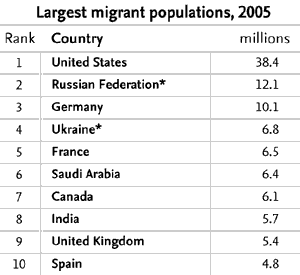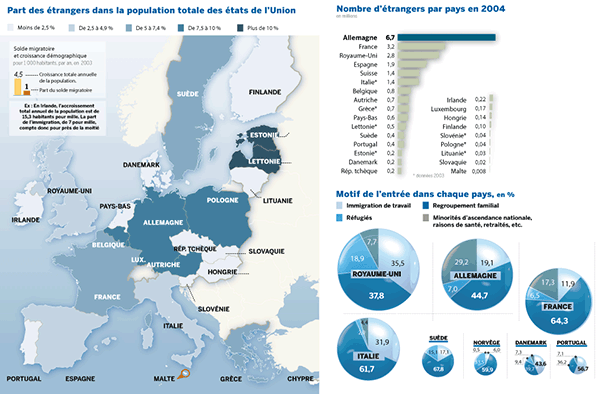Migration is considered one of the defining global issues of the early twenty-first century, as more and more people are on the move today than at any other point in human history. International Organization for Migration
Worlwide
About 192 million people (3% of the world's population or one of every 35 persons), live outside their place of birth. Between 1965 and 1990, the number of international migrants increased at an annual rate of about 2.1 %. The current annual growth rate is about 2.9 %.
Over 1/3 of world migration is from developing to industrial countries and about 1/4 between developing countries. 112 million of the migrants are living in high-income countries (about 11% of their population) and 78 million in developing countries (about 1.4 % of their population).

Migrants as share of population, 2005 - Source: The World Bank
The United States is the largest recipient of migrants. In 2005, the USA received 38 million people. Around 13% of its population is foreign-born. Western Europe (especially Germany and France), Saudi Arabia and Canada show higher percentages. Countries from the FSU, Russia and Ukraine, must be considered separately because of the break-up of the Soviet Union in 1991 (people living in one of the newly independent countries who were born in another countries were indeed classified as migrants).Among developing countries, India and Pakistan have also high immigration.
Turning to countries of emigration, Mexico, Afghanistan and Morocco show major outflows in proportionate terms and India and Bangladesh in absolute terms.

Top 10 migrant recipient countries (2005)
Source: International Organization for Migration

Top 15 sending countries (2000-2002) - Numbers in the 4 colums correpond to the absolute number of emigrants (people leaving their country), the percentage of emigrants compared to the total country population, the absolute number of emigrants to neighboring countries, and the percentage of emigrants who are going to neighboring countries - Source: The World Bank
Some features can be noted:
- much migration takes place within regions: 17% of recorded migration occurs with Europe and Central Asia and immigration to the US is dominated by Latin Americans (including Mexicans);
- South-South migration (Sub-Saharan Africa and South Asia) is quantitatively significant ;
- over half of international migration takes place between countries with linguistic ties.
Definitions of a “migrant” are various. International migrants may be recorded in terms of country of birth, country of citizenship, last country of previous residence, duration of time spent away from birthplace or last place of previous residence, purpose of their stay (visa type). The United Nations (1998) defines a migrant as "any person who changes his or her country of usual residence". Statistically, the migrant population can be equated directly with the number of foreigners: either those recorded by country of birth, the foreign-born, or that fraction of the population with foreign nationality, the foreign population.
European immigration patterns
Since 1950 Europe has continued to be an immigration receiving area. Currently, in the European Union, 11 million legalized immigrants reside, and several million more illegal immigrants have been estimated.
Europe comes after America as destination chosen by people wanting to escape from poverty, need or violence. During 2000-2005, Northern America gained 1.4 million migrants annually (net migration rate: 4.2 migrants per 1,000 population), Europe, 1.1 million (1.5) and Oceania 103,000 migrants (3.2).
The migratory behaviour within Europe is, however, heterogeneous:
- the northern zone (Ireland, United Kingdom, Finland and Sweden) has shown quite dynamic migratory movements;
- the central zone (Belgium, Denmark, Germany, France, Luxembourg, Holland and Austria) is the main focal point of attraction of immigration;
- the Mediterranean zone (Italy, Spain, Portugal and Greece) has undergone a radical change, given that this zone, once provider of emigrants for the central zone, is now a receiver of immigrants coming largely from North Africa;
- Eastern Europe has seen increased migratory flows during the early nineties, due to the economic reactivation in the eighties, the fall of the Berlin wall in 1989 and the disintegration of the Soviet Block in 1991.
The majority of the foreigners that during the past decade moved to EU countries can be included in the categories asylum/refugee and family reunification. In contrast to this general tendency, countries to the South, included in the EU during the eighties and therefore becoming the Southern boundary of the European Union, show a type of immigration that is principally economic.

Proportion of foreigners in the total population of the states of the European union - Source: Le Monde
Migration: a solution for problems of demographic ageing and welfare system sustainability ?
All the EU member states show a decrease in fertility, as well as a fall in mortality of the elderly. According to a study by the UNO, almost all of the EU countries (except Ireland) will by the year 2010 have an old-age dependency ratio of 20-30%, which means that the proportion of the population older than 65 will be around a quarter of the population between 15 and 64.
The question at hand is whether this evolution could or should be offset by an increase in net immigration, with a positive contribution to the labour market, to economic growth and to support systems of social protection.
According to the OECD (Organisation for Economic Co-operation and Development), in order to offset the increasing demographic burden and reduce the rate of dependence to favourable limits, the Member States must allow for a net immigration of 47 million persons old enough to work, the equivalent to 7 times the net immigration between 1985 and 1995.
Eurostat comes to similar conclusions, estimating that between 1995 and 2025 the EU population will increase from 372 to 386 million; the proportion of persons over 60 years old and more will rise from 15.4% to 22.4%; and the population old enough to work will decrease from 225 to 223 million.
Since 1989, net migration represents the main component of EU demographic change. In 2005, EU had an overall net gain from international migration of 1.8 million people, which accounted for almost 85% of Europe's total population growth that year.
Both academic observers and the European public are increasingly convinced that Europe's future will largely turn on how it admits and integrates non-Europeans.
Irregular migration and xenophobic attitudes
Irregular migration is by definition difficult to measure; however, the estimates show that it accounts for an important part of total migration. Europol affirms that more than 500,000 irregular immigrants  enter Europe every year.
enter Europe every year.
Immigration and minority integration consistently occupy the headlines. The issues which rival immigration - unemployment, crime, terrorism - are often presented by politicians as its negative secondary effects. Some countries have toughened their asylum laws, and pressure is growing for greater co-operation between governments.
The incorporation of immigrants in Member States has been accompanied by an increase in xenophobic attitudes and behaviours. Generally speaking, tolerance with ethnic minorities is lower in Member States with a greater proportion of immigrants than in those states with less foreign presence. According to the European Monitoring Centre on Racism and Xenophobia, an increase in xenophobic aggressions has been detected in the last few years, attributed to a rise in immigration, and to be more exact a rejection of Muslims, on the rise since the September 11, 2001 events.
The presence of immigrants and refugees brings up the question concerning the respect for human rights. The EU has clearly recognized the applicability of human rights treaties in matters related to refugees, applicants for asylum and immigrants.
Over 500,000 illegal migrants enter Europe each year. © REUTERS/JUan Medina
Sources
Europe: Population and Migration in 2005 - Migration Policy Institute
Immigration in Europe: realities and policies - INSTITUTO DE POLITICAS Y BIENES PUBLICOS
INTERNATIONAL MIGRATION 2006
Quantifying International Migration: A Database of Bilateral Migrant Stocks – The World Bank
Regional and Country Figures – International Organization for Migration
World migration 2008 – Regional Overviews
This page was written in 2009, as additional information to the poster series "10 years of Imaging the Earth"